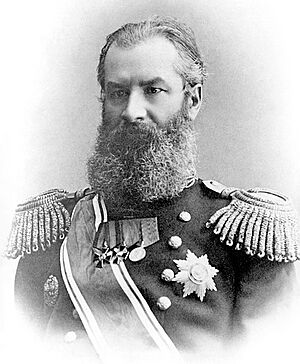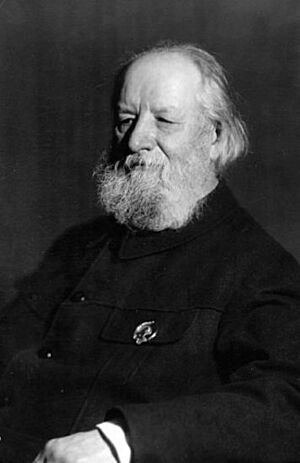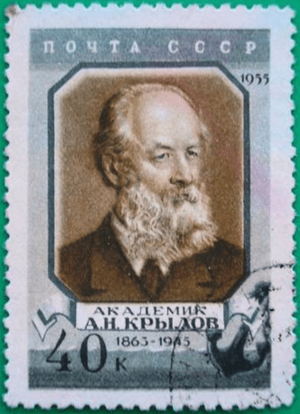Aleksey Krylov facts for kids
Quick facts for kids
Aleksey Krylov
|
|
|---|---|

Official portrait (1910)
|
|
| Native name |
Russian: Алексей Николаевич Крылов
|
| Born | August 3, 1863 O.S. (August 15, 1863 N.S.) Alatyrsky uezd of Simbirsk Gubernia, Russian Empire |
| Died | October 26, 1945 (aged 82) Leningrad, USSR |
| Buried |
Leningrad, USSR
|
| Allegiance | Russian Empire USSR |
| Service/ |
Imperial Russian Navy |
| Years of service | 1878–1917 |
| Rank | General of the fleet |
| Signature |  |
Aleksey Nikolaevich Krylov (born August 15, 1863 – died October 26, 1945) was a brilliant Russian naval engineer and mathematician. He is famous for his work on ships and how they move in water. He also wrote many books about his life and work.
Contents
Early Life and Education
Aleksey Nikolayevich Krylov was born on August 15, 1863. This was in a small village called Visyaga, in what was then the Russian Empire. His father was a retired army officer. His mother came from a well-known family, which included famous mathematicians and musicians.
In 1878, Aleksey joined the Naval College. He was a very smart student and finished with top honors in 1884. While there, he started his first scientific project. He worked on understanding how a ship's magnetic compass could be affected. This topic, especially how compasses work, interested him his whole life.
He later developed a device called a dromoscope. This machine could automatically figure out how much a compass was off. He also helped create the first full theory for the gyrocompass. This is a special compass that uses a spinning wheel to find true north.
After working for a few years, Krylov continued his studies at the Naval Academy in Saint Petersburg in 1888. He was so good that he graduated early in 1890. He then stayed at the Academy to teach mathematics and ship theory.
He became famous in the 1890s for his important work on how ships move in waves. His book, Theory of oscillating motions of the ship, was a big step forward. It explained how ships roll and pitch in the water. This was the first complete study of its kind. In 1898, he won a Gold Medal from a top naval architecture group. He was the first person from another country to receive this award.
Krylov also figured out ways to stop ships from rolling too much. He was the first to suggest using gyroscopes for this. Today, this is a very common way to make ships more stable.
After 1900, Krylov worked closely with Stepan Makarov. Makarov was an admiral and a scientist. They worked on a big problem: what happens when a ship starts to sink? Their ideas became very important and are still used worldwide. Krylov once said that Makarov's ideas about how to save a sinking ship were so ahead of their time that it took 35 years for people to understand how valuable they were.
Krylov was known for being very clever and quick-witted. He could be very direct when talking to government officials. He often said that his advice saved the government a lot of money.
Later Life and Legacy
In 1917, he became the head of a Russian shipbuilding company. After the Russian Revolution, he helped transfer the company's ships to the new Soviet government. He continued to work for the Russian Navy. In 1921, he went to London to reconnect with scientists there. He returned to the Soviet Union in 1927.
Krylov wrote about 300 papers and books. His work covered many topics, including shipbuilding, magnetism, artillery, mathematics, astronomy, and geodesy. His tables for ship floodability are used all over the world. He also studied how ships move in shallow water. He was the first to explain why ships slow down a lot in shallow areas.
In 1904, he built the first machine in Russia that could solve complex mathematical equations.
In 1931, he published a paper on what is now called the Krylov subspace and Krylov subspace methods. This work helps solve problems with eigenvalues in matrices. He focused on making calculations faster and more efficient. His method was better than others at the time and is still widely used today.
Krylov also translated Isaac Newton's famous book, Philosophiæ Naturalis Principia Mathematica, into Russian in 1915. This was the first time it was available in Russian.
Aleksey Nikolaevich Krylov passed away in Leningrad (now Saint Petersburg) on October 26, 1945. This was shortly after World War II ended. He is buried near other famous Russian scientists. He received many awards, including the Stalin Prize and the Hero of Socialist Labor title. A crater on the Moon is named Krylov after him. Also, the Krylov Peninsula and a shipbuilding research center bear his name.
He once described his work as "shipbuilding, which means applying Mathematics to various Maritime problems."
Family
Krylov married his cousin, Elisaveta Dmitrievna Dranitsyna. His daughter, Anna, married the famous physicist Pyotr Kapitsa. Pyotr Kapitsa discovered superfluidity and won the Nobel Prize in Physics.
Aleksey Krylov's grandchildren also became notable. His grandson, Andrey Kapitsa, discovered Lake Vostok. This is the largest subglacial lake in Antarctica, hidden under 4,000 meters of ice. Another grandson, Sergey Kapitsa, was a physicist and a popular TV host for a long-running Russian science show. Aleksey Krylov was very close to his son-in-law, Pyotr Kapitsa.
Victor Henri, a French-Russian scientist, was Krylov's half-brother.
See also
- Froude–Krylov force




